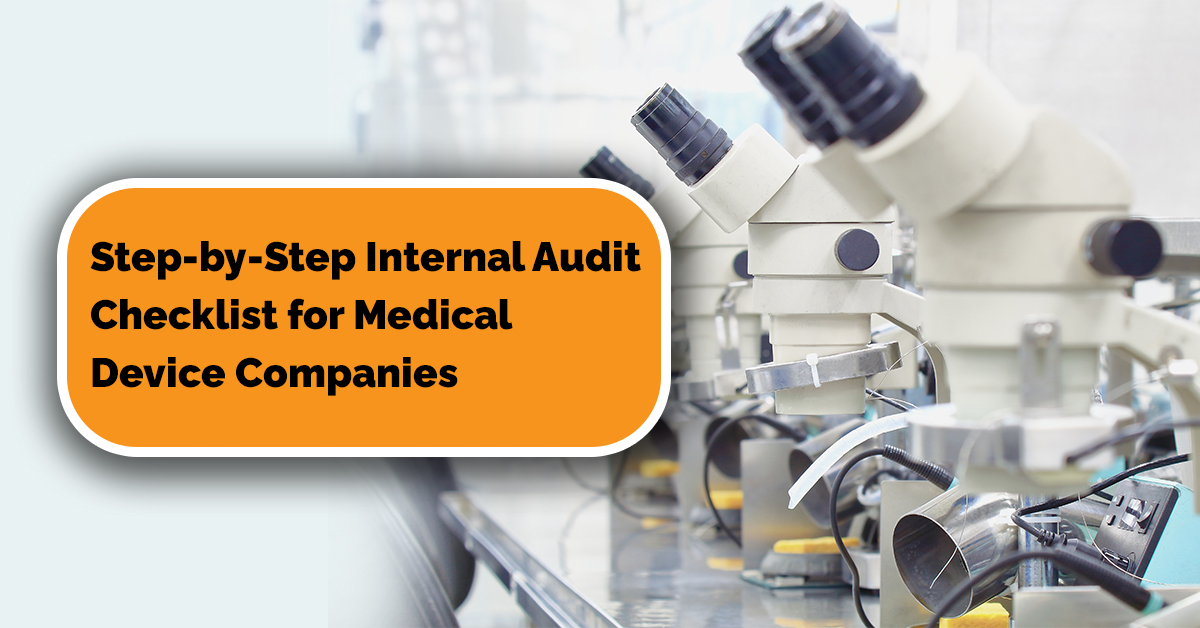Step-by-Step Internal Audit Checklist for Medical Device Companies

Hundreds of manufacturers and suppliers in the medical device industry are getting the international quality management standard ISO 13485. It is a specific standard that provides guidelines and requirements for the quality management framework in medical devices. Conforming compliance with the standard helps a medical device company to exhibit its stringent efforts for assuring the quality of medical devices and so enables them to secure a competitive place in the market. However, compliance requires rigorous internal audits of the quality management processes. While the audits can be challenging, following the internal audit checklist for medical devices will help to smoothly sail through the audit process. Audits are also an important way to improve the effectiveness of their quality management approach and further enhance the value of medical devices.
If your business operates in the medical device industry and is awaiting this ISO certification, this blog is for you. Here we present the internal audit checklist which includes the simplified steps to carry out in the audit procedure.
Internal Audit Checklist for Medical Devices that Simplifies the Audit Procedure
Audits may seem to be a time-consuming and overwhelming task but planning them properly and dividing the task into simple steps can reduce the complexity of the audit and the time required. Here is the checklist to do that.
1. Specification of the Audit Strategy
Since there are different types and purposes for audits within an organization, you need to first decide what type of audit to conduct in your medical device company. An audit can be a process audit where the internal processes or systems of the organization are checked. It can be a product audit where only final products or services are evaluated or it can be a supplier audit where all the materials, inputs, or services used in the production are checked by an external third-party organization. Then, there is a certification compliance audit which is conducted to check the conformity of quality management processes to the standard.
Therefore, the first step is to decide the specific audit strategy needed in your medical organization at present. This clearly depends on your current goals or targets. If you need to achieve the ISO standard, you will go for an internal compliance audit and hence determine the assurance processes and management system that needs to be examined.
2. Preparation for the Audit
You need to prepare everyone in the organization for the audit. The first thing to do is schedule the audit time and duration. Convey the same to the concerned teams of organizations and ask them to coordinate with their members. This will set up a clear communication line connecting everyone before the audit. Then, arrange all documents and collect supplementary data at one place for the auditors to check. This also helps in saving time.
Reviewing the reports of earlier audits (if conducted) is also an essential step in preparation. It will help you in evaluating the strengths and mistakes from the past audits so that you can act wisely this time.
3. Set Questions to Ask the Auditors
Audits are more like a learning opportunity for organizations rather than a thorough checking method. Hence, you should be eager to get the most out of this opportunity. You should prepare a long list of questions to ask the auditors such as ‘Is the documentation adequate?’, ‘what are the issues that are impacting the quality of medical devices and how to fix them?’, ‘is there any risk in the processes’, ‘what corrective actions should be taken for the risks?’, and so on. Getting as many questions answered as possible helps you to have a complete overview of your organization’s performance.
Also, you should be prepared to acknowledge any answer provided by the auditors, even if it is discerning. You should be able to deal with their views and also value the suggestions provided on improving/correcting any aspect.
4. Audit Reporting with Attention to Details
When the audit is performed, you should gather all details including essential data. Every big or small detail, as well critical or non-critical piece of information provided by the auditors must be recorded. Use them to prepare a comprehensive report of the audit. The management team will evaluate it for consequent decision making. Hence, the observations gathered from the audit must be explained for a better understanding of the management members.
5. Taking Actions and Following Up
On studying and discussing the audit report, the management team decides the next plan of actions for driving improvement in processes or systems of the organization. Implementing the actions is perhaps the most critical part of the audit that ensures an increase in the quality of the medical devices. However, that is not enough. You need to follow up on the actions taken to ensure that they have really worked out to prevent risks and improve quality, and recount them to the auditors.
Bottom Line
Medical device companies should overcome their fears and embrace audit procedures. Conducting it appropriately by following this internal audit checklist of medical devices can be helpful for your company. You can use it to identify the loopholes and mend them, recognize the need for a new process and introduce it, improve any current process, and correct any nonconformity issue against the ISO 13485 standard.
In short, carrying out an audit effectively helps your company to continually improve the quality of medical devices and also keep in compliance with the standards of regulatory bodies.
Need to conduct an internal audit for your medical device manufacturing firm? We, at Compliancehelp Consulting LLC, provide quality assurance consultation and audit services and hence, can help you in your audit process. Feel free to get in touch!


